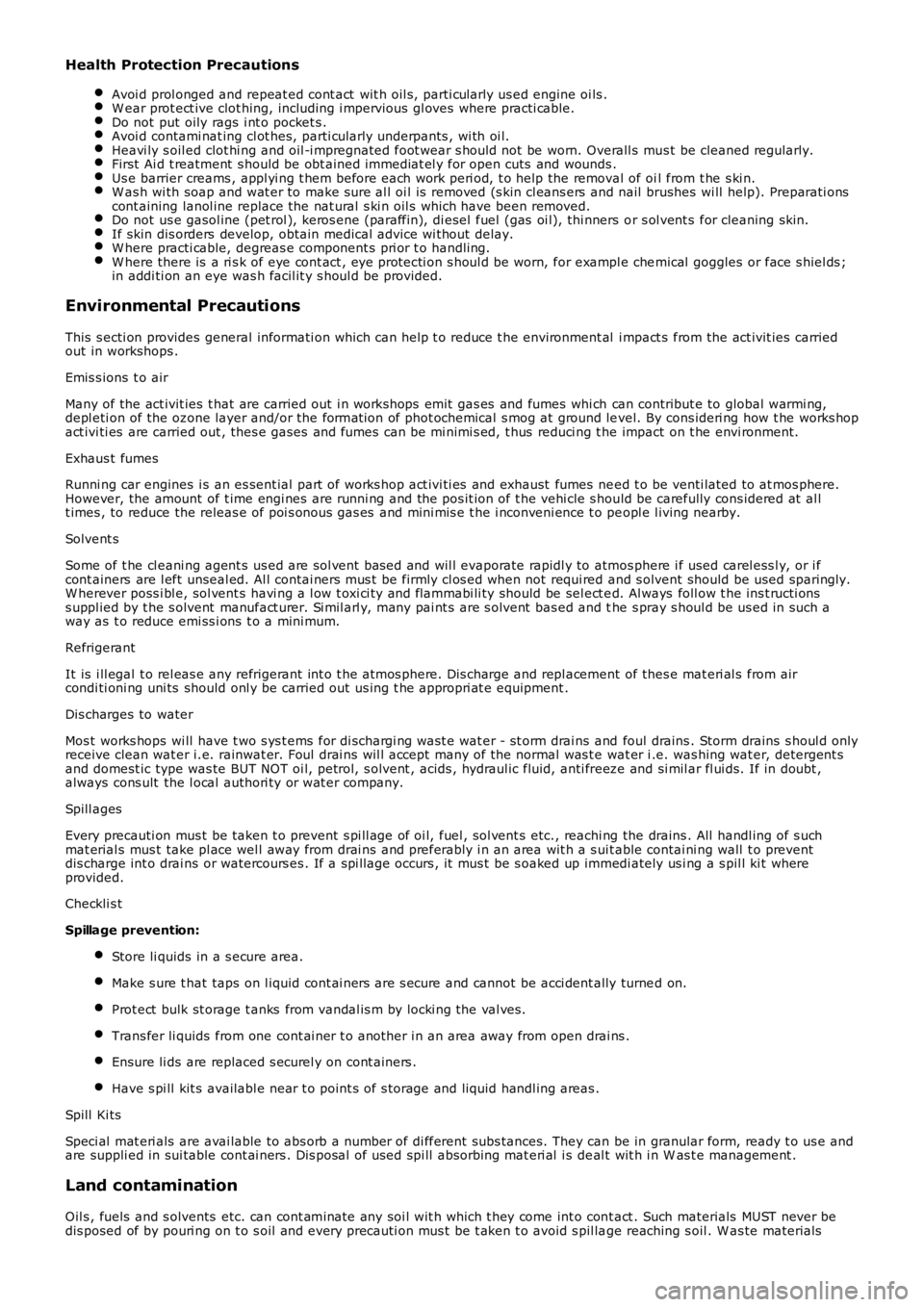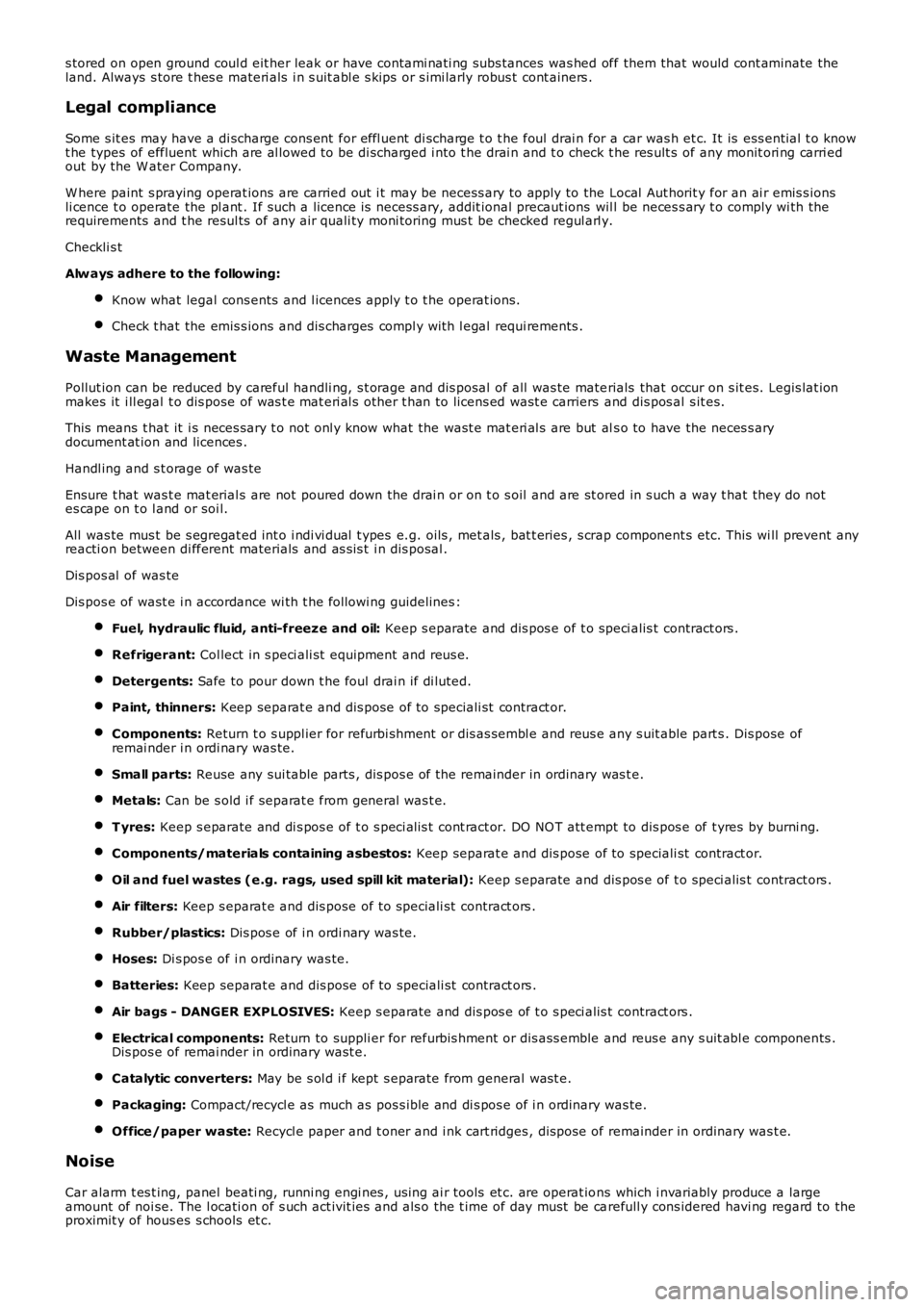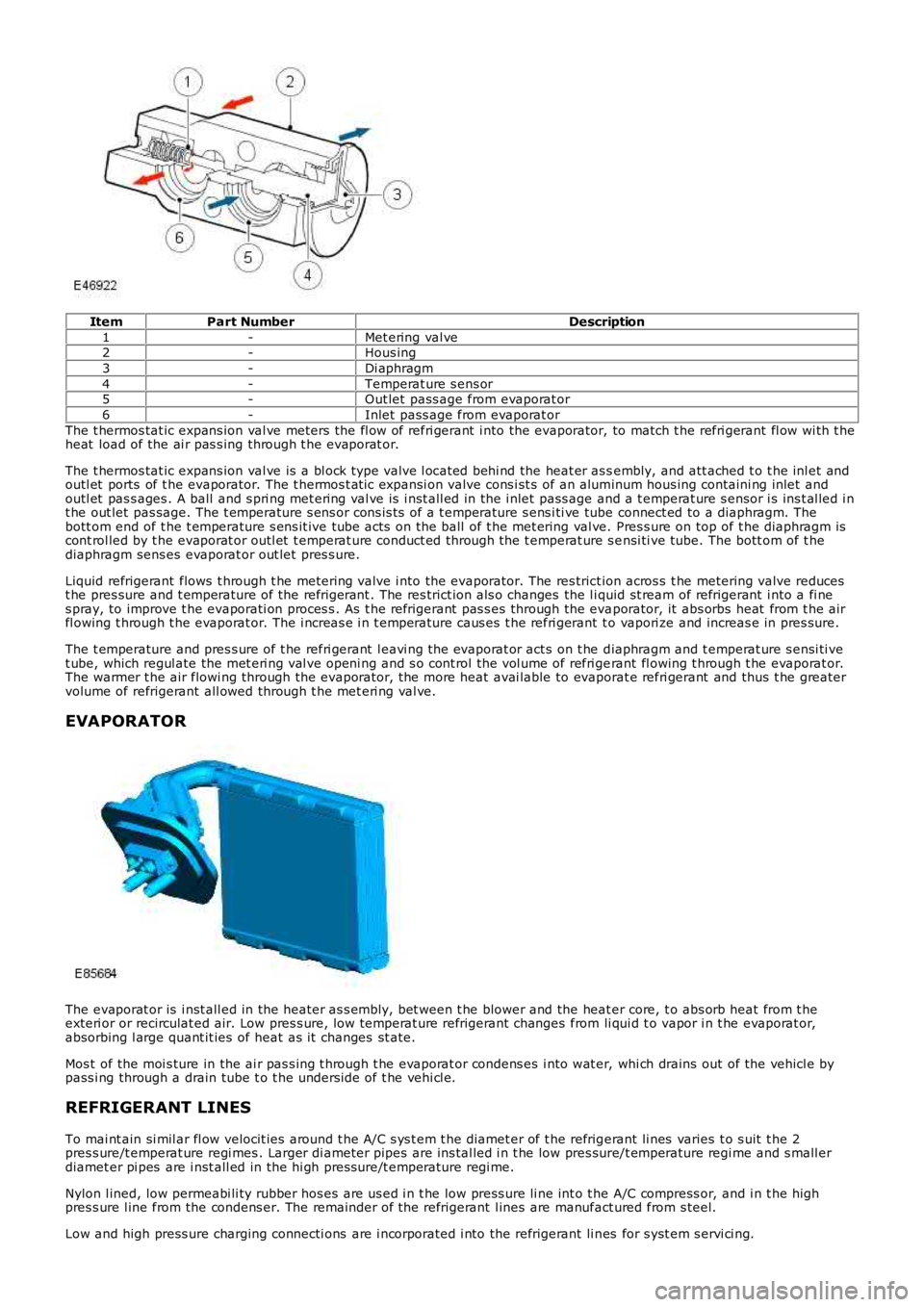2006 LAND ROVER FRELANDER 2 refrigerant type
[x] Cancel search: refrigerant typePage 39 of 3229

Health Protection Precautions
Avoi d prol onged and repeat ed cont act wit h oil s, parti cularly us ed engine oi ls .W ear prot ect ive clot hing, including i mpervious gl oves where practi cable.Do not put oily rags i nt o pocket s .Avoi d contami nat ing cl ot hes, parti cularly underpants , wi th oi l.Heavi ly s oil ed clot hi ng and oil -i mpregnated foot wear s hould not be worn. Overall s mus t be cleaned regularly.First Ai d t reatment s hould be obt ained i mmediat el y for open cuts and wounds .Us e barrier creams , appl yi ng t hem before each work peri od, t o help the removal of oil from t he s ki n.W as h wi th soap and wat er to make s ure al l oi l is removed (s kin cl eans ers and nail brushes wi ll help). Preparati onscont aining lanol ine replace the nat ural s ki n oil s which have been removed.Do not us e gasol ine (pet rol ), keros ene (paraffin), di esel fuel (gas oi l), thi nners or s ol vent s for cleaning skin.If skin dis orders develop, obtain medical advice wi thout delay.W here practi cable, degreas e component s pri or t o handling.W here there is a ri s k of eye cont act , eye protecti on s houl d be worn, for exampl e chemical goggles or face s hiel ds ;in addi ti on an eye was h facil it y s houl d be provided.
Environmental Precautions
This s ecti on provides general informati on which can help t o reduce t he environment al i mpact s from the act ivit ies carriedout in workshops .
Emis s ions t o air
Many of the act ivit ies t hat are carried out i n works hops emit gas es and fumes whi ch can contribut e to global warmi ng,depl eti on of the ozone layer and/or the format ion of phot ochemical s mog at ground level. By cons ideri ng how t he works hopact ivi ti es are carried out , thes e gases and fumes can be mi nimi s ed, t hus reduci ng t he impact on t he envi ronment.
Exhaus t fumes
Runni ng car engines i s an es sent ial part of works hop act ivi ti es and exhaust fumes need t o be venti lated to at mos phere.However, the amount of t ime engi nes are runni ng and the pos it ion of t he vehi cle s hould be carefully cons idered at al lt imes , to reduce the releas e of poi s onous gas es and mini mis e t he i nconveni ence t o peopl e l iving nearby.
Solvent s
Some of t he cl eani ng agent s us ed are sol vent based and wil l evaporate rapidl y to atmos phere i f used carel ess l y, or i fcont ainers are l eft unseal ed. Al l contai ners mus t be firmly cl os ed when not requi red and s olvent should be used sparingly.W herever poss i bl e, sol vent s havi ng a l ow t oxi ci ty and flammabi li ty should be sel ect ed. Al ways foll ow t he ins t ructi onss uppl ied by t he s olvent manufact urer. Si mil arl y, many pai nt s are s olvent bas ed and the s pray s houl d be us ed in such away as t o reduce emi ss i ons t o a mini mum.
Refrigerant
It is i ll egal t o rel eas e any refrigerant int o t he atmos phere. Dis charge and repl acement of thes e mat eri al s from aircondi ti oni ng uni ts should onl y be carried out us ing t he appropri at e equipment .
Dis charges to water
Mos t works hops wi ll have t wo s ys t ems for di schargi ng wast e wat er - st orm drai ns and foul drains . Storm drains s houl d onlyreceive clean wat er i.e. rainwat er. Foul drai ns wil l accept many of the normal was t e wat er i .e. was hing wat er, detergent sand domest ic type was te BUT NOT oi l, petrol, s olvent , acids , hydraul ic fluid, anti freeze and si mil ar fl ui ds. If in doubt ,always cons ult the l ocal authori ty or wat er company.
Spill ages
Every precauti on mus t be taken t o prevent s pi ll age of oi l, fuel , sol vent s etc., reachi ng the drains . All handl ing of s uchmat erial s mus t take pl ace wel l away from drai ns and preferably i n an area wit h a s uit able contai ni ng wall t o preventdis charge int o drai ns or watercours es . If a spi llage occurs , it mus t be s oaked up immedi ately us i ng a s pil l ki t whereprovided.
Checkli s t
Spillage prevention:
Store li quids in a s ecure area.
Make s ure t hat taps on l iquid cont ai ners are s ecure and cannot be acci dent ally turned on.
Prot ect bulk st orage t anks from vandal is m by locki ng the val ves .
Trans fer li quids from one cont ai ner t o another i n an area away from open drai ns .
Ensure li ds are replaced s ecurel y on cont ainers .
Have s pi ll kit s availabl e near t o point s of s torage and liquid handl ing areas .
Spill Ki ts
Speci al mat eri als are avai lable to abs orb a number of di fferent subs tances. They can be in granular form, ready t o us e andare suppli ed in sui table cont ai ners . Dis posal of used spi ll absorbing mat eri al i s deal t wit h i n W as t e management .
Land contamination
Oil s , fuels and s olvents etc. can cont aminate any soi l wit h which t hey come int o cont act . Such materials MUST never bedis posed of by pouri ng on t o s oil and every precauti on mus t be t aken t o avoid s pil lage reaching s oil . W as te materials
Page 40 of 3229

s tored on open ground coul d eit her leak or have contami nati ng subs tances was hed off them that would cont aminate theland. Always s tore t hes e materi als i n s uit abl e s kips or s imi larly robus t cont ainers .
Legal compliance
Some s it es may have a di scharge cons ent for effl uent di scharge t o t he foul drai n for a car was h et c. It is ess enti al t o knowt he types of effluent which are al lowed t o be di scharged i nto t he drai n and t o check t he res ult s of any monit ori ng carri edout by the W ater Company.
W here paint s praying operat ions are carried out i t may be necess ary to apply to the Local Aut horit y for an ai r emis s ionsli cence t o operate the pl ant . If such a licence is necess ary, addit ional precaut ions wil l be neces s ary t o comply wi th therequirements and t he resul ts of any air quali ty moni toring mus t be checked regul arl y.
Checkli s t
Alw ays adhere to the following:
Know what legal cons ents and l icences apply t o t he operat ions.
Check t hat the emis s ions and dis charges compl y wit h l egal requi rements .
Waste Management
Pollut ion can be reduced by careful handli ng, s t orage and dis posal of all was te materials that occur on s it es. Legis lat ionmakes it i ll egal t o dis pose of was t e mat eri al s other t han to licens ed wast e carriers and dis pos al s it es.
This means t hat it i s neces sary t o not onl y know what the wast e mat eri al s are but als o to have the neces s arydocument at ion and licences .
Handl ing and s t orage of was te
Ensure t hat was t e mat erial s are not poured down the drai n or on t o s oil and are st ored in s uch a way t hat they do notes cape on t o l and or soi l.
All was te mus t be s egregat ed int o i ndi vi dual t ypes e.g. oils , met als , bat t eries , s crap component s etc. This wi ll prevent anyreacti on between di fferent materials and as s is t i n dis posal .
Dis pos al of was te
Dis pos e of wast e i n accordance wi th t he followi ng guidelines :
Fuel, hydraulic fluid, anti-freeze and oil: Keep s eparate and dis pos e of t o s peci alis t contract ors .
Refrigerant: Col lect in s peci ali st equipment and reus e.
Detergents: Safe to pour down t he foul drai n if di luted.
Paint, thinners: Keep separat e and dis pose of to speciali st contract or.
Components: Return t o s uppl ier for refurbi shment or dis as sembl e and reus e any s uit able part s . Dis pose ofremai nder i n ordi nary was te.
Small parts: Reuse any sui table parts , dis pos e of the remainder in ordinary was t e.
Metals: Can be s old i f separat e from general was t e.
T yres: Keep s eparate and di s pos e of t o s peci al is t cont ract or. DO NO T att empt to dis pos e of t yres by burni ng.
Components/materials containing asbestos: Keep separat e and dis pose of to speciali st contract or.
Oil and fuel wastes (e.g. rags, used spill kit material): Keep s eparate and dis pos e of t o s peci alis t contract ors .
Air filters: Keep s eparat e and dis pose of to s peciali st contract ors .
Rubber/plastics: Dis pos e of i n ordi nary was te.
Hoses: Di s pos e of i n ordinary was te.
Batteries: Keep separat e and dis pose of to speciali st contract ors .
Air bags - DANGER EXPLOSIVES: Keep s eparate and dis pos e of t o s peci alis t contract ors .
Electrical components: Return to suppli er for refurbis hment or dis ass emble and reus e any s uit abl e components .Dis pos e of remai nder in ordinary wast e.
Catalytic converters: May be s ol d i f kept s eparate from general wast e.
Packaging: Compact/recycl e as much as pos s ible and di s pos e of i n ordinary was te.
Office/paper waste: Recycl e paper and t oner and i nk cart ridges , dis pos e of remainder in ordinary was t e.
Noise
Car alarm t es t ing, panel beati ng, runni ng engi nes , us ing ai r tools et c. are operat ions which i nvariably produce a largeamount of noi se. The l ocati on of s uch act ivit ies and als o the t ime of day must be carefull y cons idered havi ng regard to theproximit y of hous es s chools et c.
Page 1641 of 3229

ItemPart NumberDescription
1-Met ering val ve2-Hous ing
3-Di aphragm
4-Temperat ure s ens or5-Out let pass age from evaporat or
6-Inlet pass age from evaporat or
The t hermos tat ic expans ion val ve meters the fl ow of refri gerant i nto the evaporator, to match t he refri gerant fl ow wi th t heheat load of the ai r pas s ing through t he evaporat or.
The t hermos tat ic expans ion val ve is a bl ock type valve l ocat ed behi nd the heat er as sembly, and att ached t o t he inl et andoutl et ports of t he evaporator. The t hermos t at ic expansi on valve cons i st s of an aluminum hous ing containi ng inlet andoutl et pas s ages . A ball and s pri ng met ering val ve is i nst all ed in the i nlet pass age and a t emperat ure s ensor i s ins t al led i nt he out let pas sage. The t emperature s ens or cons is t s of a t emperature s ens i ti ve tube connect ed to a diaphragm. Thebott om end of t he t emperature s ens it ive tube acts on the ball of t he met ering val ve. Pres s ure on top of t he diaphragm iscont rol led by t he evaporat or outl et t emperat ure conduct ed through the t emperat ure s ensi ti ve tube. The bott om of t hediaphragm sens es evaporat or out let pres s ure.
Liquid refrigerant flows t hrough t he metering valve i nto the evaporator. The res trict ion acros s t he metering valve reducest he pres sure and t emperature of the refrigerant . The res trict ion als o changes the l iquid st ream of refrigerant i nto a fi nes pray, to improve t he evaporati on proces s . As t he refri gerant pas s es through the evaporator, it abs orbs heat from t he airfl owing t hrough t he evaporat or. The i ncreas e i n t emperature caus es t he refri gerant to vapori ze and increas e in pres sure.
The t emperature and pres s ure of t he refri gerant l eavi ng the evaporat or act s on t he diaphragm and t emperat ure s ensi ti vet ube, which regul ate the met eri ng val ve openi ng and s o cont rol t he vol ume of refri gerant fl owing t hrough t he evaporat or.The warmer t he air flowi ng through the evaporator, the more heat avai lable to evaporat e refri gerant and thus t he greatervolume of refrigerant all owed through t he met eri ng val ve.
EVAPORATOR
The evaporat or is i nst all ed in the heater as s embly, bet ween t he blower and the heat er core, t o abs orb heat from t heexteri or or recirculat ed air. Low pres s ure, low temperat ure refrigerant changes from li qui d t o vapor i n t he evaporat or,absorbing l arge quant it ies of heat as it changes st ate.
Mos t of the moi s ture in the ai r pas s ing t hrough t he evaporat or condens es i nto wat er, whi ch drains out of the vehicl e bypass i ng through a drain tube t o t he unders ide of t he vehi cl e.
REFRIGERANT LINES
To mai nt ain si mil ar fl ow velocit ies around t he A/C s ys t em t he diamet er of t he refrigerant li nes varies t o s uit t he 2pres s ure/t emperat ure regi mes . Larger di ameter pipes are ins tal led i n t he low pres sure/t emperature regi me and s mall erdiamet er pi pes are i nst all ed in the hi gh pres sure/t emperature regi me.
Nylon l ined, low permeabi li ty rubber hos es are us ed i n t he low press ure li ne int o t he A/C compress or, and i n t he highpres s ure l ine from the condens er. The remainder of the refrigerant l ines are manufact ured from s teel.
Low and high press ure charging connecti ons are i ncorporated i nto the refrigerant li nes for s yst em s ervi ci ng.